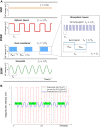Electromagnetic Field as a Treatment for Cerebral Ischemic Stroke
- PMID: 34557522
- PMCID: PMC8453690
- DOI: 10.3389/fmolb.2021.742596
Electromagnetic Field as a Treatment for Cerebral Ischemic Stroke
Abstract
Cerebral stroke is a leading cause of death and adult-acquired disability worldwide. To this date, treatment options are limited; hence, the search for new therapeutic approaches continues. Electromagnetic fields (EMFs) affect a wide variety of biological processes and accumulating evidence shows their potential as a treatment for ischemic stroke. Based on their characteristics, they can be divided into stationary, pulsed, and sinusoidal EMF. The aim of this review is to provide an extensive literature overview ranging from in vitro to even clinical studies within the field of ischemic stroke of all EMF types. A thorough comparison between EMF types and their effects is provided, as well as an overview of the signal pathways activated in cell types relevant for ischemic stroke such as neurons, microglia, astrocytes, and endothelial cells. We also discuss which steps have to be taken to improve their therapeutic efficacy in the frame of the clinical translation of this promising therapy.
Keywords: cerebral ischemia; electromagnetic field; neuroprotection; neurorehabilitation; pulsed electromagnetic field; sinusoidal electromagnetic field; stroke.
Copyright © 2021 Moya Gómez, Font, Brône and Bronckaers.
Conflict of interest statement
The authors declare that the research was conducted in the absence of any commercial or financial relationships that could be construed as a potential conflict of interest.
Figures


References
Publication types
LinkOut - more resources
Full Text Sources

